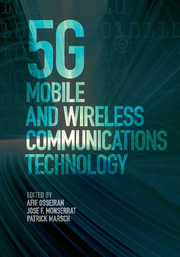Book contents
- Frontmatter
- Dedication
- Contents
- List of contributors
- Foreword
- Acknowledgments
- Acronyms
- 1 Introduction
- 2 5G use cases and system concept
- 3 The 5G architecture
- 4 Machine-type communications
- 5 Device-to-device (D2D) communications
- 6 Millimeter wave communications
- 7 The 5G radio-access technologies
- 8 Massive multiple-input multiple-output (MIMO) systems
- 9 Coordinated multi-point transmission in 5G
- 10 Relaying and wireless network coding
- 11 Interference management, mobility management, and dynamic reconfiguration
- 12 Spectrum
- 13 The 5G wireless propagation channel models
- 14 Simulation methodology
- Index
- References
6 - Millimeter wave communications
Published online by Cambridge University Press: 05 June 2016
- Frontmatter
- Dedication
- Contents
- List of contributors
- Foreword
- Acknowledgments
- Acronyms
- 1 Introduction
- 2 5G use cases and system concept
- 3 The 5G architecture
- 4 Machine-type communications
- 5 Device-to-device (D2D) communications
- 6 Millimeter wave communications
- 7 The 5G radio-access technologies
- 8 Massive multiple-input multiple-output (MIMO) systems
- 9 Coordinated multi-point transmission in 5G
- 10 Relaying and wireless network coding
- 11 Interference management, mobility management, and dynamic reconfiguration
- 12 Spectrum
- 13 The 5G wireless propagation channel models
- 14 Simulation methodology
- Index
- References
Summary
Certain 5G METIS scenarios [1] such as Amazingly Fast, Best Experience Follows You, and Service in a Crowd create extreme requirements on data rate, traffic handling capability, and availability of high capacity transport respectively. These scenarios map to corresponding requirements that will entail support of over 10 Gbps, 10–100 times the number of connected devices, 1000 times the traffic, and 5 times lower end-to-end latency than possible through IMT-Advanced. The peak data rate requirements of these scenarios will entail acquisition of several hundreds of MHz of spectrum. These requirements do not encompass 5G, but instead offer one avenue of stressing system capabilities along a limited set of dimensions. Several traffic forecasts [2][3] also predict a tenfold increase in traffic volume from 2015 to 2020.
The 5G requirements of interest to this chapter relate mainly to data rates and traffic volumes and can be met using techniques that are tried and tested in past generations of mobile networks. These are to (1) gain access to new spectrum, (2) improve spectral efficiency, and (3) densify the networks using small cells. In the case of 5G, these techniques are given new life using two means: the use of millimeter Wave (mmW) spectrum for the availability of large blocks of contiguous spectrum, and the subsequent adoption of beamforming as an enabler for high spectrum efficiency. The propagation of millimeter waves is naturally affected by physics to reduce coverage to shorter ranges. Ultra-Dense Network (UDN) deployments are therefore a consequence of the choice of frequency band, and will lead to a tremendous increase in capacity over the covered area. The increase in spectral efficiency arises out of the drastic reduction of interference in relation to signal power due to the high gain beamforming.
Spectrum and regulations
The primary motivation for using millimeter waves is the promise of abundant spectrum above 30 GHz. While mmW spectrum spans the range from 30 GHz–300 GHz, it is widely believed that the reach of mass market semiconductor technology extends up to around 100 GHz and will inevitably surpass that limit with time. Microwave bands from 3 GHz–30 GHz are just as relevant to meeting extreme requirements for 5G, and much of the discussion in this chapter is relevant to those parts of the centimeter Wave (cmW) band outside of the reach of existing systems as well, namely the region 10 GHz–30 GHz (see Figure 6.1).
- Type
- Chapter
- Information
- 5G Mobile and Wireless Communications Technology , pp. 137 - 157Publisher: Cambridge University PressPrint publication year: 2016

